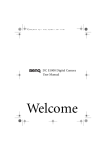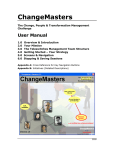Download BenQ DC P860 User manual
Transcript
DC P860 Digital Camera User Manual Welcome Downloaded From camera-usermanual.com BenQ Manuals Copyright Copyright 2007 by BenQ Corporation. All rights reserved. No part of this publication may be reproduced, transmitted, transcribed, stored in a retrieval system or translated into any language or computer language, in any form or by any means, electronic, mechanical, magnetic, optical, chemical, manual or otherwise, without the prior written permission of this company. Disclaimer BenQ Corporation makes no representations or warranties, either expressed or implied, with respect to the contents hereof and specifically disclaims any warranties, merchantability or fitness for any particular purpose. Further, BenQ Corporation reserves the right to revise this publication and to make changes from time to time in the contents hereof without obligation of this company to notify any person of such revision or changes. Taking care of your camera • Do not use your camera in the following environmental range: temperature below 0°C or above 40°C • Do not use or store your camera in the environments listed below: – Direct sunlight – High and dusty places – Next to an air conditioner, electric heater or other heat sources – In a closed car that is in direct sunlight – Unstable locations • If your camera becomes wet, wipe it with a dry cloth as soon as possible. • Salt or seawater may cause severe camera damage. • Do not use solvents, such as alcohol, to clean your camera. • If the lens is dirty, use a lens brush or soft cloth to clean the lens. Do not touch the lens with your fingers. • To prevent electric shock, do not attempt to disassemble or repair your camera by yourself. • Water may cause a fire or electric shock. Therefore, store your camera in a dry place. • Do not use your camera outdoors when it is raining or snowing. • Do not use your camera in or near water. • If a foreign substance or water gets in your camera, please turn the power off immediately and remove the batteries. Remove the foreign substance or water, and send it to the maintenance center. • Transfer the data to the computer as soon as possible to avoid losing your images and / or video clips. Disposal of Waste Electrical and Electronic Equipment by users in private households in the European Union. This symbol on the product or on the packaging indicates that this can not be disposed of as household waste. You must dispose of your waste equipment by handing it over to the applicable take-back scheme for the recycling of electrical and electronic equipment. For more information about recycling of this equipment, please contact your city office, the shop where you purchased the equipment or your household waste disposal service. The recycling of materials will help to conserve natural resources and ensure that it is recycled in a manner that protects human health and environment. CE Regulatory Notice. Hereby, BenQ Corp. declares under our responsibility that the product is in conformity with the requirements set out in the Council Directive on the Approximation of the Laws of the Member States relating, Electromagnetic Compatibility Directives (89/336/EEC, 92/31/EEC) and Low Voltage Directive (73/23/ EEC). A "Declaration of Conformity" in accordance with the above Directives has been made and is available from BenQ Corp. upon request. Statement of FCC compliance This equipment has been tested and found to comply with the limits for a Class B digital device, pursuant to Part 15 of the FCC Rules. These limits are designed to provide reasonable protection against harmful interference in a residential installation. This equipment generates, uses and can radiate radio frequency energy and, if not installed and used in accordance with the instructions, may cause harmful interference to radio communications. However, there is no guarantee that interference will not occur in a particular installation. If this equipment does cause harmful interference to radio or television reception, which can be determined by turning the equipment off and on, the user is encouraged to try to correct the interference by one or more of the following measures: • Reorient or relocate the receiving antenna. • Increase the separation between the equipment and receiver. • Connect the equipment into an outlet on a circuit different from that to which the receiver is connected. • Consult the dealer or an experienced radio/TV technician for help. Downloaded From camera-usermanual.com BenQ Manuals 1. Touring Your Camera .......................................................... 1 1.1 Checking the package contents ....................................... 1 1.2 Camera components ...................................................... 1 1.2.1 Front view ........................................................... 1 1.2.2 Rear view ............................................................. 2 1.2.3 LED indicators ..................................................... 2 2. Preparing Your Camera for Use .......................................... 4 2.1 Installing the batteries .................................................... 4 2.2 Inserting and removing an SD memory card ................... 4 3. Using the Camera ................................................................. 5 3.1 Mode dial ....................................................................... 5 3.2 LCD monitor information (camera mode) ...................... 6 3.3 Getting started................................................................ 7 3.3.1 Turning the power on / off ..................................... 7 3.3.2 Choosing the screen language ................................. 7 3.3.3 Setting the date and time ........................................ 7 3.3.4 Using the flash ...................................................... 8 3.3.5 Using the self-timer ............................................... 8 3.3.6 Setting the Focus................................................... 9 3.3.7 EV/Backlight Adjustment and AE Lock ..................... 9 3.3.8 Using the zoom function ........................................ 9 3.3.9 Capture Mode ...................................................... 9 3.4 Menu options............................................................... 10 3.4.1 Camera menu .................................................... 10 3.4.2 Scene Mode Selection ......................................... 11 3.4.3 Video mode ....................................................... 12 3.4.3.1 LCD monitor information (video mode) .......... 12 3.4.3.2 Recording video clips .................................... 12 3.4.3.3 Video menu ................................................ 12 Table of Contents Downloaded From camera-usermanual.com BenQ Manuals i English Table of Contents BenQ DC 5530 User’s Manual English 3.4.4 Playback mode ................................................... 13 3.4.4.1 LCD monitor information (image playback) ..... 13 3.4.4.2 LCD monitor information (video playback) ...... 13 3.4.4.3 Playback mode - the basics ............................. 13 3.4.4.4 Playback menu............................................. 15 3.4.5 Set-up mode ...................................................... 16 3.4.5.1 Set-up menu................................................ 16 4. PC Dependent Features...................................................... 18 4.1 Bundled software.......................................................... 18 4.2 Transferring files to your computer .............................. 18 4.2.1 Step 1: Connect the digital camera to your computer 19 4.2.2 Step 2: Download images or video clips .................. 19 4.3 PictBridge Mode .......................................................... 19 5. Troubleshooting ................................................................. 20 6. Specifications ...................................................................... 22 7. Service Information ............................................................ 23 ii Table of Contents Downloaded From camera-usermanual.com BenQ Manuals 1 TOURING YOUR CAMERA Checking the package contents Carefully unpack your kit box and ensure that you have the following items. 1. 2. 3. 4. 5. 6. 7. 8. 9. • • • 1.2 User Manual Digital camera USB cable AA Ni-MH batteries Hand strap Software CD-ROM Pouch AV cable Battery charger Available accessories may vary depending on sales region. If any of the items are missing or appear to be damaged, contact your dealer. Save the packaging in case you need to ship your camera for service. All electronic accessories (such as USB, AV cable, adapter, charger, and battery) are designed to work with this BenQ Digital Camera only. Do not use them with other Digital Camera to avoid possible damage Camera components 1.2.1 Front view 1 2 3 4 1. 2. 3. 4. 5. 6. 7. 8. 9. 5 9 8 Mode dial Shutter button Power button Flash open button Flash Speaker Lens Microphone Self-timer LED 7 6 Touring Your Camera Downloaded From camera-usermanual.com BenQ Manuals 1 English 1.1 • English If your BenQ camera's lens remains extended after an involuntary shutdown, simply replace the batteries with new ones and restart your camera. Never forces the lens inwards since this action will damage the camera and void the BenQ Warranty. 1.2.2 Rear view 1. Status LED 2. [ ] Zoom out button [ ] Thumbnail button [ ] Zoom in button 1 2 3 4 3. 4. 5. [ ] Thumbnail button Menu Menu button USB or AV OUT terminal OK Set button 6. [ ] Arrow button (Up) [ ] EV button / AE Lock [ ] Backlight correction 7. [ ] Arrow button (Right) [ ] Flash button 8. [ ] Arrow button (Down) [ ] Self-timer button 5 6 7 8 9 10 11 12 15 14 13 9. [ ] Arrow button (Left) [ ] Macro button 10. Strap eyelet 11. [ ] Delete button 12. [ ] Display button [ ] Information button 13. Battery / SD memory card cover 14. Tripod socket 15. LCD monitor 1.2.3 LED indicators Color State During photography Green On Ready for shot. On When the image is not in focus. Flashing Accessing files in progress. Flash charging in progress. Red 2 During connection to a PC Touring Your Camera Downloaded From camera-usermanual.com BenQ Manuals System ready. Accessing files in progress. • It is normal for the camera to become warm during operation, because camera casing more than 99.99% of the pixels on the LCD display meet standard specifications. Yet, it is possible that less than 0.01% of the pixels on the LCD display may have some light spots or show unusual colors. This is normal and does not indicate display malfunction, nor will this affect the pictures you take with the camera. Touring Your Camera Downloaded From camera-usermanual.com BenQ Manuals 3 English can conduct heat. • The LCD display on this camera is manufactured with sophisticated technology, and English 2 PREPARING YOUR CAMERA FOR USE 2.1 Installing the batteries You can use two AA batteries to power up the camera. Make sure that the power of the digital camera is off before inserting or removing the batteries. To insert the batteries: 1. Make sure the camera is turned off. 2. Open the battery cover. 3. Insert the batteries in the correct orientation as shown in the illustration. 4. Close the battery cover. To remove the batteries: 1. Make sure the camera is turned off. 2. Hold the camera with the battery cover facing upward, and then open the battery cover. 3. Remove the batteries. 2.2 Inserting and removing an SD memory card The camera is equipped with internal memory, allowing you to record video clips and capture images. You can also expand the memory capacity by using an optional SD (Secure Digital) memory card to store more files. 1. Always make sure the camera is turned off before inserting or removing a memory card. 2. Insert an SD memory card in the correct orientation as shown in the illustration. 3. Close the battery / SD memory card cover. To remove the SD memory card, make sure the camera is turned off. Press lightly on the edge of the memory card and it will eject. • Be sure to format the SD memory card with this camera before initial use. • To prevent valuable data from being accidentally erased • • 4 from an SD memory card, you can slide the write-protect tab (on the side of the SD memory card) to “LOCK”. To save, edit, or erase data on an SD memory card, you must unlock the card. SD memory card in the following sizes are supported: 64 MB, 128 MB, 256 MB, 512 MB, 1 GB, 2 GB and 4 GB SDHC. The camera is compatible with SD memory cards manufactured by Panasonic, Toshiba, and Sandisk. Please contact your local dealer for purchase information. Preparing Your Camera for Use Downloaded From camera-usermanual.com BenQ Manuals 3 USING THE CAMERA English 3.1 Mode dial You can select from eight shooting modes and set-up mode according to shooting conditions to achieve the desired effect. 1 2 3 4 5 6 10 7 9 8 No. Icon Mode 1 [A] Auto Description The camera automatically sets the exposure, etc. In program mode, the shutter speed and aperture will be set automatically, but other parameters may be set manually. 2 [ P] Program 3 [ Tv ] Shutter speed You may specify the shutter speed while the camera sets the corresponding priority aperture value. 4 [ Av ] Aperture pri- You may specify the aperture value while the camera sets the corresponding ority shutter speed. 5 [M] Manual pho- For full manual control over exposure, aperture and other settings. tography 6 [ 7 [SCN] SCN 8 [ ] Movie For recording video clips. 9 [ ] Playback Mode Performs image playback and deletion. 10 [ ] Set-up Specify your camera’s settings. ] Shake-Free Select this mode to reduce blur caused by camera vibration. Point-and-shoot simplicity when taking pictures under 12 special conditions. Using the Camera Downloaded From camera-usermanual.com BenQ Manuals 5 3.2 LCD monitor information (camera mode) English 7. 1 2 3 4 5 6 7 8 00008 9 AE Lock 10 F2.8 1/1250 11 12 13 19 1. 2. 3. 4. 18 [ ] On Flash [ ] Off Flash 6 15 14 8. 9. 10. 11. 12. 13. 14. [ ] 3264 x 2175 [ ] 3264 x 1835 [ ] 2560 x 1920 [ ] 1600 x 1200 [ ] 640 x 480 Available number of shots Zoom status Main focus area Aperture Shutter speed ISO White balance ] Slow Sync [ ] Auto (Default) [ ] Auto Flash (Default) [ ] Incandescent [ ] Fluorescent 1 [ ] Fluorescent 2 [ ] Day Light [ ] Cloudy [ ] Auto RedEye Flash Focus setting [ ] Auto [ ] Macro [ ] Super Macro [ ] Infinity [ ] Manual Focus ] PF Self-timer indicator [ 6. 16 ] 3264 x 2448 [ [ 5. 17 Mode indicator Voice memo indicator Flash mode Image size/Quality [ ] 10 Sec. [ ] 2 Sec. Capture mode [ ] Single [ ] Continuous [ ] AEB [ ] Manual 15. Metering [ 16. 17. 18. 19. ] Cen. Weight [ ] Spot EV Histogram AE Lock Indicator Battery condition [ ] Full battery power [ ] Medium battery power [ ] Low battery power [ ] No battery power Using the Camera Downloaded From camera-usermanual.com BenQ Manuals 3.3 Getting started English 3.3.1 Turning the power on / off • Press the [ • To turn the power off, press the [ ] button until the digital camera turns on. ] button again. 3.3.2 Choosing the screen language When the camera is turned on for the first time, a language-selection screen will be displayed on the LCD monitor. Follow the steps below to choose the desired language. 1. Rotate the mode dial to [ camera. ] mode, and then press the [ 2. Press [ ] to enter the [ button. ] menu and use [ ] button to turn on your ] to select [Language] and press the OK 3. Use [ ] / [ ] to select the language you want. 4. Press the OK button to confirm. 3.3.3 Setting the date and time Follow the steps below to set the date display style, current date and time. 1. Rotate the mode dial to [ camera. ] mode, and then press the [ 2. Press [ ] menu and press the OK button to set [Date & Time]. 3. Use [ • ] to enter the [ ]/[ ] button to turn on your ] to select Year, Month, Day and Time fields. To increase a value, press [ ]. • To decrease a value, press [ ]. • The time is displayed in 24-hour format. 4. Press the OK button after all fields are set. Using the Camera Downloaded From camera-usermanual.com BenQ Manuals 7 3.3.4 Using the flash English The flash is designed to function automatically when lighting conditions warrant the use of flash. You can capture an image using a flash mode suitable to your circumstances. 1. Rotate the mode dial to [A], [P], [Tv], [Av], or [M], and then press the [ turn on your camera. ] button to 2. Toggle [ ] / [ ] until the desired flash mode appears on the LCD monitor. 3. Compose your scene and press the shutter button. The camera has five flash modes: Auto Flash (default), Auto RedEye Flash, Slow Sync, Forced Flash and No Flash. The table below will help you choose the appropriate flash mode. Icon [ ] [ ] [ ] [ ] [ ] Flash mode Description ON FLASH The flash will always fire regardless of the surrounding brightness. Select this mode for capturing images with high contrast (backlighting) and deep shadows. OFF FLASH The flash will not fire. Select this mode in a place where flash use is prohibited, or when the distance to the subject is beyond the effective range of the flash. SLOW SYNC The flash fires with a slow shutter speed. AUTO FLASH The flash fires automatically according to the photographic conditions. This mode is not available when the camera is set to [Tv], [Av], and [M] modes. AUTO REDEYE FLASH This mode can reduce the red-eye phenomenon when you want to capture natural-looking images of people and animals in low-light conditions. • The flash cannot be used in Video Mode, burst mode [Continuous] and [AEB]. • Press the flash open button to open the flash before using. Otherwise, the flash cannot work. 3.3.5 Using the self-timer The self-timer can be used in situations such as group shots. When using this option, you should either mount the camera on a tripod (recommended) or rest it on a flat surface. 1. Secure the camera to a tripod or place it on a stable surface. 2. Rotate the mode dial to [A], [P], [Tv], [Av], [M] [ [ ] or [SCN], and then press the ] button to turn on your camera. 3. Toggle [ ] / [ ] until the desired self-timer mode appears on the LCD monitor. 4. Compose your image and press the shutter button. • The self-timer function is activated. • The image is then captured after the preset time. • To cancel the self-timer at any time, press the shutter button. • If you wish to capture another image using the self-timer, repeat these steps. 8 Using the Camera Downloaded From camera-usermanual.com BenQ Manuals 3.3.6 Setting the Focus [ ]/[ and PF . ]. The camera has six focus modes: Auto, Macro, Super Macro, Infinity, Manual 3.3.7 EV/Backlight Adjustment and AE Lock By toggling [ ] / [ ][ ], you can adjust the exposure value and backlight, as well as set the AE Lock. The AE Lock function not only allows you to compose an image conveniently but also ensures a correct exposure of the subject. 3.3.8 Using the zoom function The camera is equipped with 6X optical zoom. The lens moves during the optical zoom photography, allowing you to capture telephoto and wide-angle shots. By using the optical zoom function, images appear closer by pressing the T button, or smaller away by pressing the W button. Moreover, you can further enlarge the subjects with 5X digital zoom by pressing the T button continuously. It is activated after your camera reaches its maximum optical zoom factor (6X). A useful feature as it is, however, the more the image is magnified, the grainer the image may become. To capture a zoomed image, perform the following steps. 1. Adjust the magnification ratio by using the T / W buttons. • The digital zoom function can be disabled by setting [Digital Zoom] in [ to [Off]. 2. Compose your image and press the shutter button. ] menu • The digital magnification can be adjusted smoothly from 1.0X to 5.0X. 3.3.9 Capture Mode This sets the recording method at the time of capturing images. *[ ] Single: Capture one image at a time. *[ ] Continuous: Permits continuous photography of 3 images max. *[ ] AEB: Permits 3 consecutive images in the order of standard exposure, underexposure and overexposure compensation. 1. In the [ ] menu, use [ ] to select [Capture Mode] and press the OK button. 2. Use [ ] / [ ] to select the capture mode you want and press the OK button. 3. Press the shutter button all the way down to shoot. • In [Tv], [Av] and [M] modes, [Continuous] and [AEB] cannot be used. Using the Camera Downloaded From camera-usermanual.com BenQ Manuals 9 English You can select different focus modes according to your shooting requirements by toggling 3.4 Menu options English 3.4.1 Camera menu This menu is for the basic settings to be used when capturing still images. 1. Rotate the mode dial to [A], [P], [Tv], [Av], [M] [ [ ] or [SCN], and then press the ] button to turn on your camera. 2. Press MENU, and then use [ ]/[ ] to select [ ] or [ ]. 3. Use [ ] / [ ] to select the desired setting, and then press the OK button. 4. To exit from the menu, press the MENU button. In [ ] menu: Item Function Description Size This option sets the size of the image that will be captured. * 8M / 3 : 2 / 16 : 9 / 5M / 2M / VGA Quality This option sets the quality (compression rate) of the image that will be captured. * Fine / Standard / Economy Sharpness This sets the sharpness of the image that will be captured. * Soft / Normal / Hard Saturation This sets the saturation of the image that will be captured. * Low / Normal / High Color This sets the color of the image that will be captured. * Standard / Vivid / Sepia / Monochrome White Balance This sets the white balance for a variety of lighting conditions and permits images to be captured that approach the conditions that are seen by the human eye. * Auto / Incandescent / Fluorescent 1 / Fluorescent 2 / Day Light / Cloudy / Manual Manual WB This manually sets the white balance and stores it. Use of this is convenient when the white balance does not offer a good match. Before selecting [Execute], determine the subject (such as a white paper) that will be used to set the white balance. * Cancel / Execute ISO This sets the sensitivity for capturing images. When the sensitivity is raised (and the ISO figure is increased), photography will become possible even in dark locations, but the more pixelated (grainier) the image will appear. * Auto / 100 / 200 / 400 / 800 Metering In [ This sets the metering method for determining the exposure. * Cen. Weight / Spot ] menu: Item Capture Mode 10 Function Description This sets the recording method of capturing images. Refer to section in this manual titled “Capture Mode” for further details. * Single / Continuous / AEB Using the Camera Downloaded From camera-usermanual.com BenQ Manuals This sets whether or not to attach a voice memo for a still image. * On / Off – You can record a voice memo for up to 30 seconds after pressing the shutter button. – To stop the voice recording, press the shutter button again. Digital Zoom This sets whether or not to use digital zoom at the time of photography. * On / Off Preview Date Print 3.4.2 This sets whether or not to display the captured image on the screen immediately after the image is captured. * On / Off The date of recording can be printed directly on the still images. This function must be activated before the image is captured. * On / Off Scene Mode Selection You can select the scene mode according to your shooting requirements. 1. Rotate the mode dial to [SCN], and then press the OK button. The scene mode selection screen will appear. 2. Use [ ] / [ ] / [ ] / [ ] to select the desired scene mode and then press the OK button to confirm the setting. • Pressing [ ]/[ ] can display the descriptions of each secne mode. There are 12 available scene modes: Icon [ ] [ ] [ ] [ ] [ ] [ ] [ ] [ ] [ ] [ ] [ ] [ ] Scene mode Description High ISO Portrait Zooms-in to emphasize natural skin tones while blurring the background. Landscape Sets focus to infinity and reduces aperture to achieve max. depth of view for outdoor secnes. Sport Uses a high shutter speed to capture objects in motion. Panorama Takes a series of shots and stitches them together for a wide-angle view or continuous scene. Night Captures night scenes and portraits clearly. Please use a tripod or keep the camera steady. Fireworks Extends exposure time to capture fireworks trails. Please use a tripod or keep the camera steady. Candlelight Used for candle light source. The flash is disabled to preserve the mood. Sunset Uses sunlight white balance to enhance photo quality at sunset. Sunrise Uses sunlight white balance to enhance photo quality at sunrise. Snow Increases contrast to highlight the texture and layers of snow. Beach Increases contrast to highlight the texture and layers of sand. Plant Uses the macro mode to emphasize lines and saturation and thus highlight the details of plants. Using the Camera Downloaded From camera-usermanual.com BenQ Manuals 11 English Voice Memo 3.4.3 Video mode English 3.4.3.1 1. 2. 3. 4. 5. 6. 7. 8. LCD monitor information (video mode) Mode indicator Focus setting Self-timer indicator Video resolution/video quality Available recording time/elapsed time Zoom status Main focus area Battery condition 3.4.3.2 Recording video clips 1 2 3 4 5 12:48 6 7 8 This mode allows you to record video clips with sound via the built-in microphone. 1. Rotate the mode dial to [ ] and then press the [ 2. To start recording, press the shutter button. 3. To stop recording, press the shutter button again. ] button to turn on your camera. • When recording video clips, the flash cannot be used. • While the image is being recorded into the SD card, do not open the battery/SD card cover, nor remove the battery or SD card. Doing so might damage the SD card or destroy the data. 3.4.3.3 Video menu This menu is for the basic settings to be used when recording video clips. 1. Rotate the mode dial to [ 2. Press the MENU button. ] and then press the [ ] button to turn on your camera. 3. Press [ ] / [ ] to select the desired setting, and then press the OK button. 4. To exit from the menu, press the MENU button. Item Function Description Size This sets the size of the image that will be captured. * VGA / Q-VGA Quality Color 12 This sets the quality (compression rate) of the image that will be captured. * Fine / Standard This sets the color of the image that will be captured. * Standard / Vivid / Sepia / Monochrome Using the Camera Downloaded From camera-usermanual.com BenQ Manuals 3.4.4 Playback mode LCD monitor information (image playback) 1. Playback mode 2. Recorded date and time 3. File number/total file number 4. Histogram 5. Metering 6. Flash mode 7. ISO 8. Exposure value 9. White balance 10. Image size/quality 11. Mode indicator 12. DPOF indicator 13. Protect indicator 14. Voice memo indicator 3.4.4.2 1. 2. 3. 4. 1 2 03/20/2007 12:00 14 021/154 3 13 4 12 100-0001 3460KB 1/200 F2.8 11 10 9 8 7 6 5 LCD monitor information (video playback) Playback mode Mode indicator File number/total file number Play indicator 3.4.4.3 1 3 2 4 Playback mode - the basics 3.4.4.3.1 Viewing images You can display the still images you have just captured. 1. Press the [ ] button to turn on your camera. 2. Rotate the mode dial to [ ]. • The last captured image appears on the LCD monitor. 3. Use [ ]/[ ] to select the desired images. • To view the previous image, press the [ • To view the next image, press the [ • Press [ ]/[ ] button. ] button. ] to toggle between different display modes of playback information. Using the Camera Downloaded From camera-usermanual.com BenQ Manuals 13 English 3.4.4.1 3.4.4.3.2 Magnifying images English While reviewing your images, you may enlarge a selected portion of an image. This magnification allows you to view fine details. The zoom factor displayed on the screen shows the current magnification ratio. 1. Rotate the mode dial to [ ]. 2. Adjust the zoom ratio by using the Zoom [W] / [T] button. • To enlarge the selected image, press the [T] button. • To return to the normal image, press the [W] button. • The magnification factor is displayed on the LCD monitor. 3. To view different portions of the images, press the [ [ ]/[ ]/[ ]/ ] button to adjust the display area. • The range of magnification is from 1x to 8x in 0.5x increments. 3.4.4.3.3 Thumbnail display This function allows you to view up to 9 thumbnail images on the LCD monitor simultaneously so you may search for a particular image. 1. Rotate the mode dial to [ ]. 2. Press the [W] / [ ] button once. • The images are displayed in the thumbnail display. • Images that have been selected with the [ • [ ] / [ ] buttons will be indicated by a green frame. When there are ten or more images, scroll the screen with the [ ]/[ ]/[ ]/ ] buttons. 3. Use the [ ] / [ ] / [ ] / [ ] button to select the image to be displayed at regular size. 4. Press the OK button to display the selected image at its regular size. As appropriate, the [ 3.4.4.3.4 ], [ ], [ ], [ ] icons will be displayed in a thumbnail display. Rotating Images While reviwing your images, you can rotate the displayed image 90 degree clockwise or counterclockwise. 1. Rotate the mode dial to [ • ]. Press [ ] button to rotate the displayed image 90 degree counterclockwise. Press [ ] button to rotate the displayed image 90 degree clockwise. 2. Press the OK button to save the rotated image. The original image will be replaced by the rotated one. • 14 Using the Camera Downloaded From camera-usermanual.com BenQ Manuals 3.4.4.3.5 Deleting Images/Video Clips 1. Rotate the mode dial to [ 2. Press [ English Use this function to delete one or all images/video clips stored on SD memory card or in the internal memory. Please note that the deleted images or video clips cannot be recovered. Exercise caution before deleting a file. ]. ] button to display the delete screen. 3. Use [ ] / [ ] to select the desired option and press the OK button. • [Single]: Delete the displayed image/video clip. • [All]: Delete all stored images/video clips. • [Slect]: Select the image/video clip from the thumbnail display and then delete it. 4. Select [Execute] with [ ] / [ ] and then press the OK button. • Select [Cancel] and press the OK button to cancel deletion and return to the image playback. 3.4.4.4 Playback menu 1. Rotate the mode dial to [ ]. 2. Press the MENU button, and then use [ setting and press the OK button. ]/[ ]/[ ]/[ ] to select the desired 3. To exit from the Playback menu, press the MENU button. Playback 1: Item Function Description Slide Show The slide show function allows you to play your images back automatically in sequential order. This is very useful and entertaining feature for reviewing captured images and for presentations. You can select the slide show display interval. * 3 sec. / 5 sec. / 10 sec. – Video clips display only the first frame and are not played back. – To stop the slide show, press the OK button. DPOF This option allows you to select the desired images to be printed and set the number of prints and date displayed in DPOF format. You can print images easily just by inserting the memory card to a DPOF compliant printer or in a print shop. Protect This option sets the data to read-only to prevent images from being erased by mistake. Resize This option allows you to change the size of a captured image to an available smaller size. However, the following images cannot be resized: – Image size 3:2, 16:9 and VGA – Image captured with other camera – Protected images – Video clips – Images cannot be resized when the SD card is write-protected. – Images cannot be resized to 3:2 or 16:9. Copy To Card This option allows you to copy your files from the digital camera’s internal memory to a memory card. This action can be performed only when you have a memory card installed and some files in the internal memory. * Cancel / Execute Using the Camera Downloaded From camera-usermanual.com BenQ Manuals 15 Quality Change English This option allows you to change the quality (compression rate) of a recorded image. Only quality changing to a lower quality level is available * Standard/Economy 3.4.5 Set-up mode 3.4.5.1 Set-up menu This feature allows you to set the default settings by preference for using your camera. 1. Rotate the mode dial to [ camera. 2. Press [ ]/[ ] mode, and then press the [ ] to select the [ ]/[ ] button to turn on your ] menu. 3. Use [ ] / [ ] to select the desired option item, and then press the OK button. 4. To exit from the set-up menu, rotate the mode dial to other desired mode. In [ ] menu: Item This option displays the size and the remaining memory of the SD memory card loaded in the camera. Fr. No. Reset This creates a new folder on your memory card. From this point forward, newly captured images are stored in the newly created folder starting with image number 0001. * Cancel / Execute Format This option erases all images and reformats the SD memory card loaded in your camera. Protected images are also erased. The SD memory card cannot be formatted if it is writeprotected. * Cancel / Execute Beep This option sets whether the camera sound will be muted every time when you press the camera buttons. * On / Off Auto Off If no operation is performed for a specific period of time, the camera power will be automatically turned off. This feature is useful to reduce battery wear. * 3 Min./ 5 Min./ 10 Min. / Off USB LCD Bright. In [ This option allows you to choose one of the following modes for further settings. * PC / PictBridge This option sets the brightness of the LCD monitor. The adjustment range is from -5 to +5. ] menu: Item 16 Function Description Card Info. Function Description Date/Time This option sets the date and time. Refer to 3.3.3 “Setting the date and time” for further details. Sys. Reset This option returns all basic settings to the digital camera’s default settings. The time setting will not be reset. * Cancel / Execute Using the Camera Downloaded From camera-usermanual.com BenQ Manuals Language Video Output This option sets the video output system of the video equipment that you are going to connect to the camera. * PAL / NTSC System Info. This option displays the current firmware version of the camera. Using the Camera Downloaded From camera-usermanual.com BenQ Manuals 17 English This option sets the language that is displayed on the LCD monitor. Refer to 3.3.2 “Choosing the screen language” for further details. English 4 PC DEPENDENT FEATURES 4.1 Bundled software The camera is supplied with the following software. To install the software, refer to the information supplied with respective CDs. ArcSoft PhotoImpression 5 Combine l'édition de photos avec des outils d'amélioration créative et de partage d'outils qui maximise votre expérience média numérique. ArcSoft VideoImpression 2 Crée des présentations multimédia en combinant des photos et des clips vidéo avec de l'audio, du texte et des transitions entre les scènes. 4.2 Transferring files to your computer After using USB cable to establish a USB connection between the camera and your computer, you can use your computer to share captured images or recorded video clips with your family or friends via e-mail or post them on the Web. Note that before you begin, you need to check your system according to the table as shown below. System Requirements (Windows) 18 CPU Pentium III 600 MHz or higher Operating System Windows 2000 / ME / XP / Vista RAM 64 MB Hard Disk Space 128 MB hard disk space Required Devices A CD-ROM drive An available USB port PC Dependent Features Downloaded From camera-usermanual.com BenQ Manuals 4.2.1 Step 1: Connect the digital camera to your computer 2. In the [ ] menu, select [USB] with the then press the OK button. / English 1. Rotate the mode dial to [ ], and then press the [ button to turn on your camera. ] and 3. Select [PC] with the / and then press the OK button. 4. Connect one end of the USB cable to an available USB port on your computer. 5. There will be a new “Removable Disk” icon detected in “My Computer”, which contains your captured images or recorded video clips. 4.2.2 Step 2: Download images or video clips When the digital camera is turned on and connected to your computer, it is considered to be a disk drive, just like a floppy disk or CD. You can download (transfer) images by copying them from the “Removable Disk” to your computer hard drive. Windows Open the “Removable Disk” and double-click on the DCIM folder to open it to find more folders. Your images are inside these folder(s). Select the desired still images or video clips, and then choose “Copy” from the “Edit” menu. Open the destination location (folder) and choose “Paste” from the “Edit” menu. You may also drag and drop image files from the digital camera to a desired location. • Memory card users may prefer to use a memory card reader (highly recommended). • Video playback application is not included with the package. Make sure that video playback application has been installed in your computer. 4.3 PictBridge Mode Even if you do not have a computer, you can connect the camera directly to a printer that supports PictBridge to perform image selection and printing using the camera monitor screen and controls. PictBridge support also enables you to specify which images you want to print and how many copies of each should be printed. To connect the camera to the printer: 1. Rotate the mode dial to [ 2. In the [ ], and then press the [ ] menu, select [USB] with / ] button to turn on your camera. and then press the OK button. 3. Select [PictBridge] with / and then press the OK button. 4. Connect your camera and the printer via a supplied USB cable. The screen turns off automatically and the setting screen will appear on the monitor after seconds of time. PC Dependent Features Downloaded From camera-usermanual.com BenQ Manuals 19 English 5 TROUBLESHOOTING Refer to the symptoms and solutions listed below before shipping your camera for service. If the problem persists, contact your local reseller or service center. Symptom Cause The camera cannot be There is no battery or the battery is powered up. not inserted correctly. The battery has no power. The battery power is draining quickly. Solution Insert the battery correctly. Recharge the battery. The external temperature is extremely low. — Many shots are being captured in dark places, requiring a flash. — The battery was not fully charged. Fully charge the battery and disThe battery has not been used for an charge it for at least one complete extended period of time after being cycle before use. charged. The battery or camera The camera or flash was used conis warm. tinuously over a long period of time. The flash does not fire. The camera flash is turned off. Set the flash to Auto Flash. The light source is sufficient. Even though the flash fired, the image is dark. The distance to the subject is greater Get closer to the subject and shoot. than the flash’s effective range. The image is too bright or too dark. The exposure is excessive or inadequate. Reset exposure compensation. I cannot format a memory card. The memory card is write-protected. Remove the write protection. End of the memory card life. Insert a new memory card. The free space on the hard disk of your computer is insufficient. Ensure that the hard disk has enough space for running Windows and that the drive for loading image files has free space equal to or greater than the memory card in the camera. I cannot download images. There is no power being supplied to Recharge your batteries or replace the camera. with new batteries if necessary. 20 Troubleshooting Downloaded From camera-usermanual.com BenQ Manuals Cause Solution The camera does not shoot even when pressing the shutter button. The battery is running low. Recharge the battery. The camera is not in Shooting Mode. Switch to Shooting Mode. The shutter button was not pressed all the way down. Press the shutter button all the way down. The internal memory or memory card does not have any free space. Load a new card or delete unwanted files. The flash is recharging. Wait until the flash mode icon, indicated on the screen, stops flashing. The camera does not recognize the memory card. Format the memory card before the initial use or before using with another camera. English Symptom I cannot print images with PictBridge compliant printers. Please turn on the camera, select The camera is connected to the printer when the camera is powered [PictBridge] and then connect to the printer. off. A “File Full” message appears and the camera connot shoot. Number of files and/or folders may have exceeded the system limit. Back up existing data, and then remove some or all of these files and folders. When you start shooting later, the system will automatically create folders. Troubleshooting Downloaded From camera-usermanual.com BenQ Manuals 21 English 6 SPECIFICATIONS Item Description Image sensor CCD Effective pixels 8.0 Mega pixels Image / Video size Still image (JPEG): 3264 x 2448, 3264 x 2175, 3264 x 1835, 2560 x 1920, 1600 x 1200, 640 x 480 Video clip: 640 x 480, 320 x 240 Recording media 18 MB internal memory SD memory card Zoom Optical: 6X Digital: 5X Lens F-no.: Wide: 2.8 / Tele: 4.8 Focal length: 7.8 mm - 46.8 mm (equivalent to 37 mm - 222 mm on a 35 mm camera) LCD monitor 2.5" TFT color LCD (153.6K pixels display) Self-timer 10 sec delay, 2 sec delay Exposure compensation -2.0EV~ +2.0EV (in 0.3EV increments) White balance Auto, Incandescent, Fluorescent 1, Fluorescent 2, Day Light, Cloudy, Manual ISO Auto/100/200/400/800 Interface USB 2.0 connector, A / V terminal Power 2 x AA batteries (Alkaline or Ni-MH) Dimensions Approx. 99.8 x 65 x 27.5 mm (42.5mm with lens ring) Weight Approx. 182g (without batteries and the SD memory card) * Design and specifications are subject to change without notice. 22 Specifications Downloaded From camera-usermanual.com BenQ Manuals SERVICE INFORMATION Technical Support For free driver updates, product information and news releases, visit the following web site: http://www.BenQ.com Service Information Downloaded From camera-usermanual.com BenQ Manuals 23 English 7





































